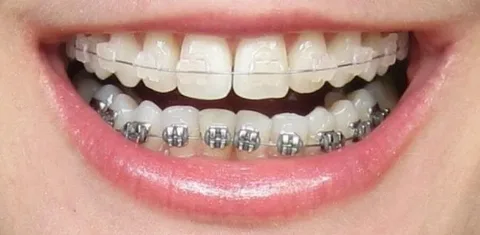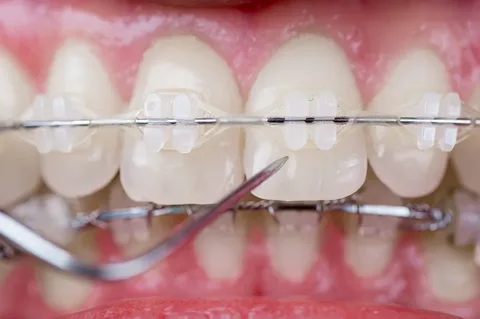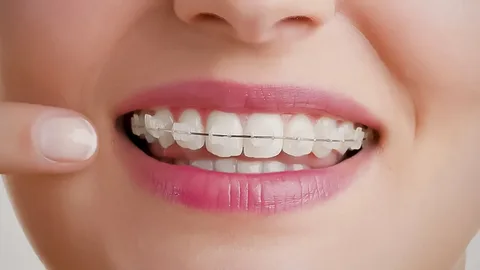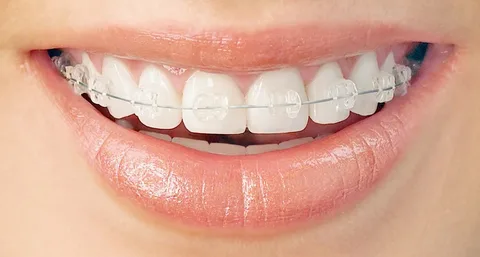Ceramic Braces: A Modern Approach to Orthodontic Treatment
Ceramic braces offer a discreet and aesthetically pleasing alternative to traditional metal braces, making them a popular choice for teens and adults seeking orthodontic treatment. This guide explores what ceramic braces are, how they work, their benefits, and other essential details to help you decide if they are the right choice for your needs.
How Do Ceramic Braces Work?
The process for ceramic braces is similar to that of metal braces:
Initial Consultation:
The orthodontist examines your teeth, bite, and oral health using X-rays and impressions to create a customized treatment plan.
Placement of Braces:
Ceramic brackets are bonded to the teeth with dental adhesive.
A wire is threaded through the brackets and secured with elastics or clips, applying pressure to move the teeth gradually.
Regular Adjustments:
Every 4–6 weeks, the orthodontist adjusts the wires and elastics to ensure steady progress.
Completion of Treatment:
Once the desired alignment is achieved, the braces are removed, and a retainer is provided to maintain the results.
What Orthodontic Issues Can Ceramic Braces Address?
Ceramic braces are effective for treating a variety of dental issues, including:
Misaligned or crooked teeth
Overcrowding
Gaps between teeth
Bite problems such as overbite, underbite, or crossbite
While they can address most orthodontic problems, ceramic braces may not be suitable for very severe cases requiring significant force.
Benefits of Ceramic Braces
Discreet Appearance:
The brackets blend with your natural tooth color, making them much less noticeable than metal braces. This feature is particularly appealing to adults and older teens.
Effective Treatment:
Ceramic braces provide the same level of precision and effectiveness as metal braces for most orthodontic issues.
Comfortable Material:
The ceramic material is smooth and less likely to irritate the cheeks and gums compared to traditional metal brackets.
Customizable Options:
Patients can choose between clear or tooth-colored elastics, further enhancing the aesthetic appeal.
Limitations of Ceramic Braces
Cost:
Ceramic braces are typically more expensive than metal braces due to the advanced materials used.
Fragility:
Ceramic brackets are more brittle than metal and may chip or break under excessive pressure.
Staining:
While the brackets themselves resist staining, the elastic ties can discolor over time if exposed to foods like coffee, tea, or curry.
Longer Treatment Time:
In some cases, treatment may take longer compared to metal braces because ceramic braces apply less force.
Care and Maintenance of Ceramic Braces
To ensure the best results and maintain the discreet appearance of ceramic braces, proper care is essential:
Maintain Oral Hygiene:
Brush your teeth and braces after every meal using a soft-bristled toothbrush and fluoride toothpaste.
Use a floss threader or water flosser to clean between teeth and around brackets.
Avoid Staining Foods:
Limit consumption of foods and drinks that can stain the elastic ties, such as coffee, tea, wine, and brightly colored sauces.
Be Gentle:
Avoid hard or sticky foods that can damage the brackets or wires. Examples include nuts, hard candies, and chewing gum.
Attend Regular Appointments:
Visit your orthodontist regularly for adjustments and to monitor progress.
Use Orthodontic Wax:
Apply orthodontic wax to any brackets or wires causing irritation to the cheeks or gums.
Key features about Ceramic braces

Discreet Appearance

Effective and Precise

Comfortable Design
Frequently asked questions
Here are descriptions for FAQs about Ceramic braces to provide a clear understanding:
Yes, ceramic braces are effective for most orthodontic issues. However, they may not be ideal for severe cases requiring significant force.
The ceramic brackets resist staining, but the elastic ties can discolor over time. Replacing the ties during regular adjustments helps maintain their appearance.
Many patients find ceramic braces to be more comfortable because the brackets are smoother and less irritating to the cheeks and gums.
Treatment duration varies depending on the complexity of the case but typically lasts between 18 and 36 months.
Yes, ceramic braces are an excellent choice for adults who want effective orthodontic treatment with a more discreet appearance.

